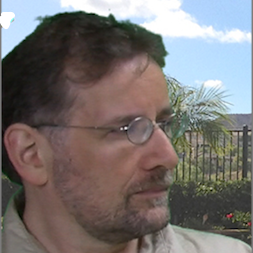[by John Robert Marlow]
TRICKY TRANSITIONS
Few works of fiction relate events in a continuous flow, from start to finish. Sometimes the story moves back in time (as with flashbacks); more often it jumps forward, sparing the reader the dull details of ordinary life. Frequently, the transition will take the reader from one location (and set of characters) to another, lending a godlike perspective unavailable to the characters themselves. Each of these transitions has its place, and each is—if not handled properly—fraught with peril.
Transitions are probably the single biggest source of confusion I encounter when editing unpublished manuscripts—many of which are otherwise of decent, even outstanding quality. Confusion stops the read, interrupts the flow of the story, and pulls the reader out of the world the writer has worked so hard to create. Worst of all, it gives the reader an excuse to put your book down and go do something else. And if the reader’s last impression was one of confusion—they may never pick it up again.
TIME-JUMPS AND PLACE-JUMPS
Time-jumps are just that: passages where the story jumps from one time to another—usually later—time. Very often, this is accompanied by a change in location. Typically, the author is switching from what’s going on with Character A at Location A to events taking place (again, typically at a later time) around Character B at Location B, and then going back to pick things up with Character A. Occasionally, the narrative will stay with Character A while jumping ahead (sometimes changing location, sometimes not). When handled poorly, any of these moves can be confusing—sometimes wildly so.
Problems arise when the reader is not crystal clear on time or place or characters present in the scene. This is one of those situations where everything is probably quite clear in the author’s head—but perhaps not quite so clear on the page. As with typos, we as authors tend to fill in the blanks: because we know how it’s supposed to read, that’s the way we see it—even though that’s not what’s actually on the page. The moment someone else picks it up—someone not intimately familiar with the story, and so unable to fill in the blanks—confusion reigns.
I cannot count the number of times I’ve been reading an otherwise competently (occasionally brilliantly) written manuscript, only to find myself grinding to a dead halt at a transition point—confused about time, place, character, or some combination of the above. Fortunately, this is easy to avoid (or fix) if you keep the following guidelines in mind.
When you jump ahead (or back) in time, say so immediately: “Later,” “That night,” “The next morning,” “Three weeks earlier,” and similar phrases make good, solid, confusion-busting openings for the first sentence describing events in the new time. The same goes for location: openers like “Later at Sam’s house,” “That night at the concert,” “The next morning in the bedroom,” serve to clarify both time and place.
Another way to do this—when appropriate—is through the use of headings, or what Hollywood calls slug lines: “Moscow, Soviet Union / 1989″ for example, saves a lot of explaining. Such headings are most often used in prologues, which tend to take place in the past. If you do this, and the next chapter takes place somewhere (or somewhen) else, be sure to employ another heading there—”Cleveland, Ohio / The Present” for example. Don’t go overboard with this technique, though: I recall one military thriller manuscript that started each and every chapter with a multiline heading stating city, country, specific locale, and time of day. Absent some extraordinarily good reason for doing this, such antics can appear amateurish.
More typically, you might use a heading or two in your opening chapters to establish your main locations, and then revert to more standard techniques, trusting the reader to remember (with the help of a few narrative reminders) what those locations are. For example: to explain time, place, and character at the start of a transition, something as simple as “Later at Sam’s house, I …,” “That night at the concert, Janice …,” or “The next morning in the bedroom, the twins …” will serve to start readers out on the right foot. What you don’t want is a scene where there seem to be two characters, then someone else speaks, then someone else, then someone else—with the reader continually “recasting” the scene on the fly. The important thing is this: regardless of where the scene is headed, you want your readers to know exactly where, when, and with whom they’re starting off.
There are exceptions: Situations in which you’re deliberately concealing (with good reason) the when, the where, or the who from the reader; situations where the character himself is unsure of one or more of these elements and you want to get this confusion across to the reader. The Bourne Identity, for example, opens with a character who hasn’t a clue about any of these things—including his own name. More often, you might have a character who’s drugged or kidnapped (or both), wakes in a strange place—and so doesn’t know where he is, how much time has passed, or what other characters might be nearby. Even in such cases, however, care must be taken to avoid disorienting the reader to the point of confusion, which will stop the read. There’s a difference between uncertainty and confusion.
DREAMS, VISIONS, AND FLASHBACKS
These are transitions of another sort, but share many potential pitfalls with time- and place-jumps. Anytime you go into a flashback, dream sequence, or vision of any kind (psychic, religious, hallucinatory), you are walking on thin ice above a sea of confusion; one false step, and things become baffling—sometimes incomprehensible—for the reader.
Here again, problems can arise when any one of three things becomes unclear: time, place, or identity. But now add a fourth variable: perspective. You may get away with being intentionally unclear or ambiguous on time, place, or (in some cases) identity—a psychic vision of the future isn’t likely to come with time, date, and place stamps—but when it comes to perspective, lack of clarity can be deadly.
I recall a particular fantasy novel manuscript in which three different characters had the ability to see through the eyes of various animals and insects. Each character would occasionally drop into an alternate perspective, which was described in some detail. Trouble was, there would often be no warning that this was about to happen: one moment Character A is standing in a field; the next we’re seeing through the eyes of an insect. At times, the point-of-view would bounce back and forth between human and critter. In some places, there were so many characters projecting into so many creatures that it was impossible to discern who was seeing what, as what.
In other instances, a character would see into the future—but it quickly became unclear what was future-vision and what was present-day reality. The result was occasional (and total) confusion. Editors are paid to read a story regardless of flaws. Readers, on the other hand, will quickly abandon what cannot be understood, or is too difficult to decipher.
The trick here is to maintain clarity when it comes to perspective or point-of-view: if we’re seeing a vision of the future (or the past or some distant place, for that matter), we need to know that (unless, perhaps, the character himself does not). We also need to know where that vision ends and present-day reality resumes. If we’re being dropped into a sudden flashback, we need to know that, too—as well as when we return to the present. And so on. As a general rule, you can get as wild as you like with the visions, etc. (the film Batman Begins employs seamlessly executed flashbacks within flashbacks; do not try this at home), so long as the reader knows where they begin and end.
Dreams often break this pattern. Here, the reader may find himself in the dream, and realize it was a dream only when the character suddenly wakes. If you’re very careful, you can do this with visions, flashbacks, etc. so long as the technique is appropriate to the situation—when, for example, the vision, etc. first appears to be a part of everyday reality. In most cases, this technique will not be appropriate, because the sudden shift from reality to vision, etc. will confuse or disorient the reader.
But here too, there are exceptions: situations in which the character himself is disoriented and you’re trying to get this across to the reader; situations where you’re intentionally blurring the line between reality and vision, etc. because (for example) that line is no longer clear to the character in question. Either can be a tricky proposition, and both are easily fumbled. Proceed with caution.
SKIPPERS
The skip-ahead or “skipper” occurs when the story is clearly leading up to a specific event—but instead of showing that event, the author skips past it, picks up later, and continues with the story. Often, the event will later be referred to as having taken place, even though we never saw it. The event itself is almost always an important one. In one book I edited, the lead character was running for president after the sitting president resigned. Among the things that were not shown (but were referred to after the fact): the president’s resignation, the hero’s announcement, the race being called for the hero, and the hero’s acceptance speech. In one manuscript I read, the entire story led inevitably toward a large battle—that never happened because the unpublished author was “saving it” for the sequel.
The problem in both cases is that when you build toward an important event, you also build the reader’s expectation that he or she will witness that event taking place. By failing to show it, you disappoint or frustrate the reader by creating an expectation that you then fail to meet. It’s also confusing: why build toward something important—and then not show it?
When you build toward an event, fulfill the reader’s expectations by showing it. Do not skip past it and pick up afterward. You’re not shooting a movie here; your production costs are the same whether you’re writing about coffee at the local café or the destruction of civilization. In fact, ask yourself this question: if this were a movie, would I expect to see this scene? If the answer is yes, make damned sure you include it.
PERSPECTIVE EXCEPTIONS
There are exceptions to showing events as they happen, and most of these involve perspective and/or situations where there’s some compelling reason not to show the event in chronological order. Such exceptions are rare. One example would be a story in which the character who experiences the event lies to another character about what took place, and you need to keep the reader in the dark as well. In this situation, showing the event as it happened would make it impossible to tell the story in this way because the reader won’t be misled by the lie. It’s even possible to depict the past event in an entirely false manner—again because the character is lying.
The film Courage Under Fire, for example, presents multiple versions of the same event, each related by a different character with a personal stake in the outcome of a military investigation. The Usual Suspects (spoiler alert: skip this sentence if you’ve not seen the movie) depicts an entirely fictional storyline from start to finish—again because a character is lying. Both Identity and High Tension (more spoilers coming) depict fictional storylines because the main characters are delusional. In the Bad Blood episode of The X-Files, viewers are treated to different versions of the same event as actually perceived by two different characters, neither of whom is (from their perspective) lying. The result is (and is meant to be) hysterically funny.
DIALOGUE IN TRANSITIONS
Opening a transitional scene with dialogue is almost always a mistake, and probably triples your chances of confusing the reader. The problem in this case is invariably the same: the speaker is not immediately identified—and the longer that situation continues, the greater the confusion. I’ve seen entire paragraphs of dialogue preceding any speaker attribution. Sometimes lengthy dialogue will push the attribution onto the next page. The issue here is that long blocks of dialogue deprive the reader of the vital information mentioned above: when, where, and who.
The solution is simple: if you open the transition with dialogue, immediately identify the speaker—unless the decision not to serves some clearly identifiable purpose. Not at the end of a paragraph, and not after two or three lines. Right away. If the first spoken line is more than a few words, ID the speaker in the middle of the sentence. Not “If I’m not mistaken, there’s a hungry tiger crouching several yards to your left,” Bob whispered. But “If I’m not mistaken,” Bob whispered, “there’s a hungry tiger crouching several yards to your left.” But even that won’t work if you’re opening with a new character, because now instead of wondering about that hungry tiger, the reader’s wondering, “Who the heck is Bob, and who’s he talking to?” Which is why you shouldn’t open scenes with dialogue from unfamiliar characters. Unless, perhaps, the speaker is also unknown to the more familiar characters who are both listening and immediately identified. (And even that’s iffy.)
Returning to something touched on above: A frequent variation on this kind of thing is to drop the reader into a new scene with one or two familiar characters. Then a third character—one we didn’t know was there—speaks. Then a fourth. Then a fifth. Then maybe we find out they’re at a party or something, and the room is full of people. When you write a scene like this, you are pulling the rug out from under the reader, over and over again. Because you led them to believe they understood the scene: one or two people in a room, say. Then you told them “Nope, surprise: you were wrong” and they must now reimagine the scene with three people in it. And then four. And then five. And so on. Which is frustrating and disorienting for the reader, even if they’re already familiar with the “pop-up characters.” So don’t do that.
CONCLUSION
Anytime you find yourself writing a transition, ask the following questions: Is this transition necessary? Is it absolutely clear where and when we are in the story, and which characters are present? If you’re opening with dialogue, is the speaker’s identity immediately clear, and do we know who the character is speaking to? And, after all of that: Is there any possible way that any of these details could be misread or misinterpreted? When you can say yes to the first three and no to the last, you’re ready to roll—and not before.
Finally, if you could use some feedback on how you’re doing or would like to get some help in shoring up your approach to managing viewpoint, transitions, and timelines in your novel, please drop me a line.
copyright © by John Robert Marlow







